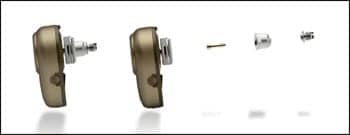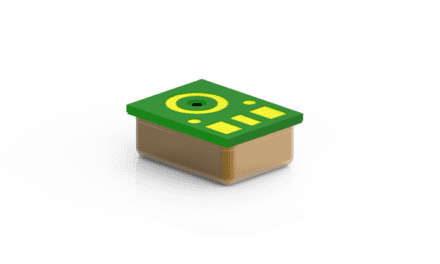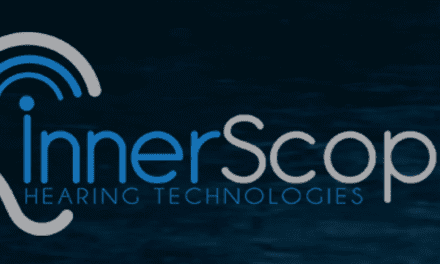Advanced bone anchored hearing systems are no longer a “device of last resort.” Instead, for some patients, they represent agentsof- change, facilitating a paradigm shift in that these systems may be considered the primary and preferred treatment option.

|
| This article was submitted to HR by Douglas L. Beck, AuD, director of professional relations at Oticon Inc, Somerset, NJ. Correspondence can be addressed to HR or Douglas L. Beck, AuD, at . |
Thomas Kuhn is credited with popularizing the term “paradigm shift” in his book The Structure of Scientific Revolutions.1 In brief, a paradigm shift is a change in the way one thinks—a change in one’s global viewpoint. Paradigm shifts typically follow the invention or implementation of “an agent of change” such as telescopes, the printing press, the telegraph, the telephone, automobiles, airplanes, and, of course, the Internet. These agents-of-change arguably facilitated significant paradigm shifts with regard to science, transportation, information technology, the acquisition of new knowledge, and more.
Likewise, advanced technology bone anchored hearing systems can be seen as agents of change. The specific paradigm shift under way is to no longer think about these systems as the “last resort” offered to patients only after all other options have been exhausted. Rather, for appropriate candidates, advanced bone anchored hearing systems (BAHS) can be considered the primary and preferred treatment.
Long-term results from bone anchored hearing systems have demonstrated safe, effective, and highly beneficial results for appropriate patients.2 Worldwide experience with these systems has been gathered for more than 30 years,3 yet innovative and beneficial applications and innovations continue to emerge.
In this case, the agents of change have been significant software and hardware-based advances in bone anchored hearing systems. The Oticon Medical Bone Anchored Hearing System processor is built on one of the most advanced digital sound processors available (the Oticon RISE platform). The processor is programmed by the audiologist based on the individual patient’s bone conduction thresholds, as well as their unique listening requirements and preferences. Additionally, the multitude of hardware and surgical advances related to the implant, the abutment and the ergonomics of the processor have positioned bone anchored hearing systems to be the primary and preferred treatment for specific hearing disorders.
Patient Selection and Candidacy
In general, candidates for bone anchored hearing systems include those with conductive hearing losses, mixed hearing losses, and single-sided deafness. Specifically, patients implanted with bone anchored systems include people with:
- Therapy-resistant draining or chronic otitis media;
- Congenital ear malformations;
- Aural atresia;
- Mastoidectomy patients with ongoing hearing loss;
- Ossicular disease not amenable to surgical correction;
- Cholesteatoma;
- Post-operative acoustic neuroma patients with one remaining normal hearing ear;
- Multiple single-sided deafness etiologies (trauma, sudden sensorineural hearing loss, etc);
- Conductive hearing loss in their only
- Various syndromes, and more.
Audiograms and Pure Tone Thresholds
When considering bone anchored hearing systems, the traditional interpretation of the audiogram requires modification. Specifically, when considering these systems, air conduction thresholds are of little concern; the primary concerns are the air-bone gap and the bone conduction thresholds. Patients with an average puretone bone conducted threshold (based on 500, 1000, 2000 and 3000 Hz) better than 45 dBHL may be considered candidates. Indeed, when the air-bone gap exceeds 30 dB, bone conduction performance is apt to be better than traditional air conduction amplification (see Snik et al2).
With regard to word recognition scores (ie, speech discrimination scores), candidacy inclusion requires scores of 60% or better. In the case of single-sided deafness, the remaining ear should have an average puretone air conduction threshold better than 20 dBHL to effectively minimize head shadow effects.
In cases of “bilaterally symmetric” bone conduction scores, the bone conduction puretone averages should be within 10 dB of each other (or within 15 dB at a specific frequency) to appreciate the benefits of bilateral fittings, such as improved speech thresholds, better speech recognition in noise, and better localization ability.
Literature Review
Bosman et al4 reported bilateral fittings of bone conduction hearing systems on 25 patients. A total of 19 had recurrent otorrhoea (or otitis externa) and 6 had congenital atresia, and all had symmetric bone conduction thresholds. The authors noted bilaterally fitted bone anchored hearing system patients experienced improved directional hearing, as well as significant improvements regarding speech recognition in noise with the second unit. Specifically, the percentage of correct localization judgments essentially doubled (based on 500 and 2000 Hz noise bursts), going from 22.2% and 24.3%, respectively, with unilateral fittings to 42% and 45% with bilateral fittings. Speech reception thresholds for sentences also significantly improved in quiet, going from 41.7 dB in unilateral fittings to 37.5 dB in bilateral fittings. Thus, bilaterally fitted bone anchored hearing devices (in appropriate patients) result in binaural hearing.

|
| FIGURE 1. The Oticon Medical Ponto bone anchored hearing system. |
Lustig et al5 reported on 40 patients and presented a retrospective analysis from 12 participating US medical centers. The authors implanted patients with preoperative bone conduction puretone averages of 60 dB or better. The most common reason for implantation was chronic otitis media or draining ears (18 patients), followed by external auditory canal stenosis or aural atresia (7 patients). The average improvement across all patients was noted as 32 dB (±19 dB). Closure of the preoperative air-bone gap occurred (within 10 dB) in 32 patients, closure within 5 dB occurred in 24 patients, and “over-closure” occurred in 12 patients. The authors stated the bone anchored hearing system was reliable and predictable in appropriate patients with conductive or mixed hearing loss who were otherwise unable to benefit from air conduction amplification.
Niparko, Cox, and Lustig6 compared traditional contralateral routing of signal (CROS) hearing aid fittings to bone anchored hearing systems in 9 patients who had one remaining normal-hearing ear. Patients included 9 adults: 7 postoperative acoustic neuroma patients, 1 patient unilaterally deafened from meningitis, and 1 patient with unilateral deafness from sudden sensorineural hearing loss. The authors reported poor acceptance of traditional CROS amplification systems versus consistent satisfaction with the bone anchored hearing system. Additionally, they noted that the bone anchored hearing system allowed significantly improved speech recognition in quiet and in certain noisy situations. They concluded BAHS overcomes some headshadow effects associated with unilateral deafness, and provides greater benefits than the CROS system.
Snik et al2 published outcomes from their scientific roundtable discussions held in 2004. With regard to surgical procedures, they noted adults can undergo a one-stage surgical procedure in the operating room under local anesthesia, whereas children require a two-stage procedure under general anesthesia. They stated the implant team should minimally consist of an otolaryngologist, a surgeon, and an audiologist. They also noted bone anchored systems provided audiologic results superior to traditional bone-conduction systems. In patients with bilateral conductive hearing loss and symmetric bone conduction thresholds, binaural hearing benefit (such as improved directional hearing, diotic summation, and improvements regarding speech-in-noise) was apparent. With regard to single-sided deafness, they noted bone anchored hearing systems act as a “transcranial CROS.” However, although “stereophonic hearing” will not occur, negative effects from head shadow will be minimized. With regard to patients with significant unilateral air-bone gaps, bone anchored hearing devices applied to the conductive side allowed the perception of binaural cues.
Wazen et al7 reviewed their patients with conductive, mixed, and single-sided deafness who were implanted with bone anchored hearing systems. Of the 218 patients evaluated, no major complications were reported. The authors reported 4.5% of patients required revisions due to soft-tissue issues and 1.3% needed revision due to failure to osseointegrate. A total of 106 of their patients completed a questionnaire, and 92% of these patients reported using the device regularly (on average, 10.1 hours per day). They concluded BAHS are safe and effective for patients with conductive and mixed hearing loss and for people with single-sided deafness. They noted the high success rate and the high satisfaction rate, combined with the predictable outcome, render bone anchored hearing systems among leading choices for auditory (re)habilitation.
Yuen et al8 reported on 21 consecutively implanted patients with singlesided deafness. All patients demonstrated significant speech reception threshold improvements as measured with the Hearing-In-Noise Test (HINT), as well as improvements noted on the Abbreviated Profile of Hearing Aid Benefit (APHAB) and the Glasgow Hearing Aid Benefit Profile (GHABP) questionnaires. They concluded bone anchored hearing systems provided significant benefits and improved speech understanding in noise.
Culmination of Hardware and Software
Bone anchored hearing systems have performed admirably while providing outstanding safety and efficacy in appropriate patients with conductive, mixed, and single-sided deafness hearing losses. Titanium bone anchored implants are CT and MRI compatible. Significant softwareand hardware-based advances in bone anchored hearing systems have facilitated a paradigm shift, positioning bone anchored hearing systems as the primary and preferred treatment for specific hearing disorders.
Pre-Op Trials for Patients
Bone anchored hearing systems are unlike other surgical approaches because the patient can literally “try it before they buy it.” For many years, these systems have offered preoperative evaluations and trials using traditional headbands and test bands. These simple devices allow patients to wear the device in their own acoustic environments (home, school, work, recreation, etc) for days or weeks at a time so they can evaluate the benefits of bone conducted sound.
Additionally, as children under the age of 5 years are not eligible for bone conduction hearing systems in the United States, pediatric “soft bands” are available to allow bone conducted speech and other sounds to be delivered to children prior to age 5 years.
Snik et al2 reported “the overall conclusion is that the vast majority of patients benefitted significantly” when they changed from their traditional bone conduction system to their bone anchored hearing system. The authors stated the bone anchored hearing system is “superior to conventional bone conductors.” Therefore, even though the preoperative trial is very important and is not to be minimized, the majority of patients report their bone anchored implant system has a better quality of sound and is louder than the trial equipment.
New Opportunities and Challenges
For audiologists, bone anchored hearing systems present multiple challenges. The first challenge is to become familiar and comfortable with BAHS as an option or recommendation for patients with appropriate hearing disorders. Another challenge is to counsel patients with regard to realistic expectations, benefits, and limitations, as well as cosmetic issues and hygienic concerns for the tissue surrounding the implant (many audiologists currently address these issues with cochlear implant patients, and similar issues require attention regarding bone anchored hearing systems). Nonetheless, perhaps the major challenge for the audiologist is to maximally program the sound processor to meet the unique, ongoing, and changing needs of the individual.
New Bone-Anchored Hearing System Technology
Ponto and Ponto-Pro Sound Processor. The Ponto and Ponto-Pro sound processors are digitally programmable to individually customize and maximize directionality, frequency shaping, multiple programs, alerting beeps, and automatic gain (loudness) control. Ponto and Ponto-Pro are programmed via the user-friendly and intuitive “Genie Medical” audiology-based fitting software. The new system builds upon decades of bone anchored hearing system success while adding advanced sound processing, ergonomics, durability, and maximal cosmetic appeal. It is available in three colors with left and right versions.
The Ponto and Ponto Pro feature low battery warning, mute and program switch, start-up delay, directionality, wind-noise reduction, volume control, left and right versions, multiple color options, multiple input connections such as direct audio input (DAI), telecoil and FM, programming through Oticon Genie Medical software, 10-channel frequency response shaping, and output automatic gain control (AGC). Ponto Pro also offers automatic multiband adaptive directionality, Tri-State noise reduction, datalogging, and learning volume control (the system self-adapts to the user’s preferred listening levels).
Realistic expectations and counseling. As is true with traditional hearing aid amplification, cochlear implants, and assistive devices, assessing and managing patients with regard to realistic and achievable hearing outcomes is of paramount importance. Multiple factors impact the specific counseling approach, including the type and degree of hearing loss, diagnosis, listening needs, acoustic environments, and personal expectations unique to each patient. Counseling issues that should always be addressed include keeping the abutment clean and dry, the physical appearance of the device, knowledge about the abutment protruding from the head, surgical issues, and possible negative outcomes.2
Contraindication. Importantly, contraindications to bone anchored hearing systems include psychiatric issues, immature personality, drug and alcohol abuse, and inability to maintain a hygienic abutment and surrounding skin. Indeed, poor hygiene is the chief reason for skin reactions.3 Additionally, in the United States, implantation in children below the age of 5 years is contraindicated.
Discussion and Conclusion
Bone anchored hearing systems have been available for almost three decades. Advanced systems have been built on a solid foundation of prior scientific and clinical outcomes, as well as testimonials and case studies proving substantial benefit for patients with conductive hearing loss, mixed hearing loss, and patients with single-sided deafness.
| ADDITIONAL READING: Rehabilitative Aspects of ISSNHL, by Maurice H. Miller, PhD, and Jerome D. Schein. December 2003 HR. Etiologies and Treatment Options for Sudden Sensorineural Hearing Loss, by Jose N. Fayad, MD, and Antonio De La Cruz, MD. December 2003 HR. Effectiveness in Treating Single-Sided Deafness with the Baha System, by Carol A. Sammeth, PhD, and George Cire, AuD. April 2009 HR. |
In appropriate candidates, bone anchored hearing systems are very well tolerated. Patients using them demonstrate high levels of user satisfaction. Beyond the primary goal of improved hearing, these systems have demonstrated improvements in behavior, concentration, learning, and development in children using bone anchored hearing solutions.9 Additionally, for people with approximately equal cochlear thresholds and bilateral conductive hearing loss, binaural hearing benefits are apparent.
Thus, advanced bone anchored hearing systems represent agents of change, facilitating a paradigm shift, such that these systems may be considered the primary treatment option for appropriate patients.
Acknowledgement
Sections of this article have been abstracted from the comprehensive Oticon White Paper on this topic, which can be found at www.oticonmedical.com.
References
- Kuhn T. The Structure of Scientific Revolutions. Chicago: University of Chicago Press; 1962. Available at: www.des.emory.edu/mfp/Kuhnsnap.html.
- Snik AF, Mylanus EAM, Proops DW, Wolfaardt JF, Dent M, Hodgetts WE, Somers T, Niparko JK, Wazen JJ, Sterkers O, Cremers WRJ, Tjellstrom A. Consensus statement on the BAHA system: where do we stand at present? Ann Otol Rhinol Laryngol. 2005;114(12) [Suppl 195]:1-12.
- Tjellstrom A, Hakansson B, Granstrom G. Bone-anchored hearing aids. In: Maniglia AJ, Proops DW, eds. Implantable Electronic Otologic Devices: State of the Art. Otolaryngol Clin North Am. 2001; 34(2). Philadelphia: W.B. Saunders. ISSN 0030-665.
- Bosman AJ, Snik AF, van der Pouw CT, Mylanus EA, Cremers CW. Audiometric evaluation of bilaterally fitted bone-anchored hearing aids. Audiology. 2001;40(3):158-176.
- Lustig LR, Arts HA, Brackmann DE, et al. Hearing rehabilitation using the BAHA bone-anchored hearing aid: results in 40 patients. Otol Neurotol. 2001;22(3):328-334.
- Niparko JK, Cox KM, Lustig LR. Comparison of the bone anchored hearing aid implantable hearing device with contralateral routing of offside signal amplification in the rehabilitation of unilateral deafness. Otol Neurotol. 2003;24(1):73-78.
- Wazen JJ, Young DL, Farrugia MC, Chandrasekhar SS, Ghossaini SN, Borik J, Soneru C, Spitzer JB. Successes and complications of the BAHA system. Otol Neurotol. 2008;29(8):1115-1119.
- Yuen HW, Bodmer D, Smilsky K, Nedzelski JM, Chen JM. Management of single-sided deafness with the bone anchored hearing aid. Otolaryngol-Head Neck Surg. 2009;141(1):16-23.
- McDermott AL, Williams J, Kuo MJ, et al. Quality of life in children fitted with a bone anchored hearing aid. Otol Neurotol. 2009; 30:344-349.
Citation for this article:
Beck DL. Shifting Paradigms: Bone Anchored Hearing Systems. Hearing Review. 2010;17(1):22-26.






